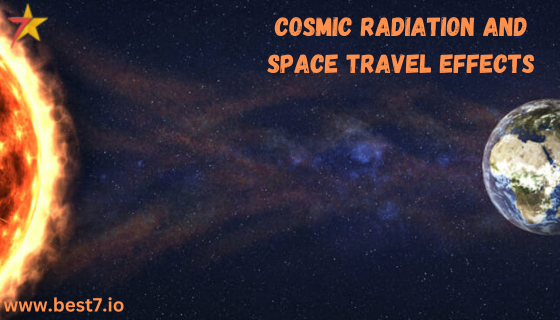
For the radiation environment in space, it is cosmic radiation that manifests itself as a principal issue compromising astronaut health and mission safety. With humanity rapidly advancing towards the goal of more extensive exploration of our solar system, especially with prospective missions to Mars and beyond, studying the effects of cosmic radiation is paramount. In this article, we will take a closer look at cosmic radiation and its sources, as well as the possible health risks it poses to astronauts during long-term missions, along with the countermeasures that are being devised to reduce or eliminate these effects.
Cosmic Radiation: Understanding Its Nature
The high-energy particles in cosmic radiation come from outer space, mainly including cosmic rays (protons and heavy ions), i.e., subatomic particles moving at almost the speed of light. Some of these particles make their way beyond the Earth’s atmosphere and magnetic field, but only a small fraction ever reaches the surface as the atmosphere acts like an insulative shield.
Increased Exposure in Space
Astronauts in space are exposed to orders of magnitude greater levels of radiation than Earth-based humans. Cosmic rays can reach outer space since it has no atmospheric and magnetic field protections from the Earth, and that indeed requires the protection of spacecraft and spacesuits. The farther one goes from the ground and into deep space, the higher the intensity of cosmic radiation as there is very little protective shielding.
Sources of Cosmic Radiation
Origin of cosmic radiation: Cosmic radiation can be divided into two major types—galactic cosmic rays (GCRs) and solar particle events (SPEs).
- Galactic Cosmic Rays (GCRs): These come from other parts of the solar system, generally as a result of such things as supernova explosions and high-energy astronomical events. GCRs account for most of the radiation exposure to astronauts on a long-term mission.
- Solar Particle Events (SPEs): These bursts of radiation are related to solar flares and coronal mass ejections from the Sun. While occurring less frequently than GCRs, SPEs deliver large doses of radiation over short periods and pose special risks due to their sudden appearance.
Health Risks Due to Cosmic Radiation
This is a significant health hazard, particularly for astronauts on extended missions in outer space. Radiation exposure is associated with major health issues, such as:
- Cancer Risk: Prolonged exposure to cosmic radiation increases the risk of cancer, with estimates suggesting a 3-5% rise in risk for each Sievert of exposure.
- Acute Radiation Syndrome (ARS): High doses over short periods, such as during massive solar events, can result in ARS with debilitating symptoms like nausea and fatigue.
- Central Nervous System Impacts: Studies suggest potential effects on learning, memory, mood, and cognitive functions due to radiation exposure.
- Cardiovascular Damage: Radiation-induced vascular damage and inflammation may raise the risk of long-term cardiovascular disease.
Monitoring and Mitigating Radiation Exposure
Radiation monitoring: Protecting astronauts requires advanced tracking systems like NASA’s Radiation Assessment Detector (RAD), which measures radiation environments in space. These systems help predict exposure and develop safety measures for future missions.
Shielding Technologies for Space Exploration
- Material Advancements: Materials such as polyethylene and hydrogen-rich compounds are particularly effective against GCRs.
- Spacecraft Design Improvements: Strategic placement of crew quarters within spacecraft enhances shielding during high-radiation events.
- Active Shielding: Experimental methods using magnetic or electrostatic fields may deflect charged particles, revolutionizing radiation protection.
Space Missions and Cosmic Ray Studies
NASA’s Artemis Program and Beyond: The Artemis program aims to land humans on the Moon and assess its radiation environment, paving the way for Mars missions. Similarly, Mars 2020’s Perseverance rover gathers crucial radiation data to design protective habitats for astronauts.
Importance of International Collaboration
Efforts by NASA, ESA, and Roscosmos underscore the need for shared resources and expertise. Collaborative research initiatives enhance understanding of radiation health effects and develop safeguards for future missions.
The Cosmic Journey Ahead
The challenges posed by cosmic radiation require advancements in technology, monitoring, and international cooperation. By addressing these concerns, humanity can ensure safer and more ambitious space exploration. Efforts to improve our understanding of cosmic radiation today will define the success and safety of missions to Mars and beyond.
Pioneering Health Research
Research into radiation’s impacts on DNA, cell function, and biomarkers will guide astronaut health protocols, ensuring long-term safety during deep-space missions.
Ethical Considerations in Space Exploration
Transparent communication about radiation risks and mitigation strategies is crucial to maintaining public trust and addressing ethical concerns regarding astronaut safety.
Defining the Future of Space Exploration
The road to interplanetary exploration demands continued research, advanced technology, and cooperation. Cosmic radiation remains one of humanity’s greatest challenges, but overcoming it will unlock boundless possibilities for discovery and survival in the cosmos.












